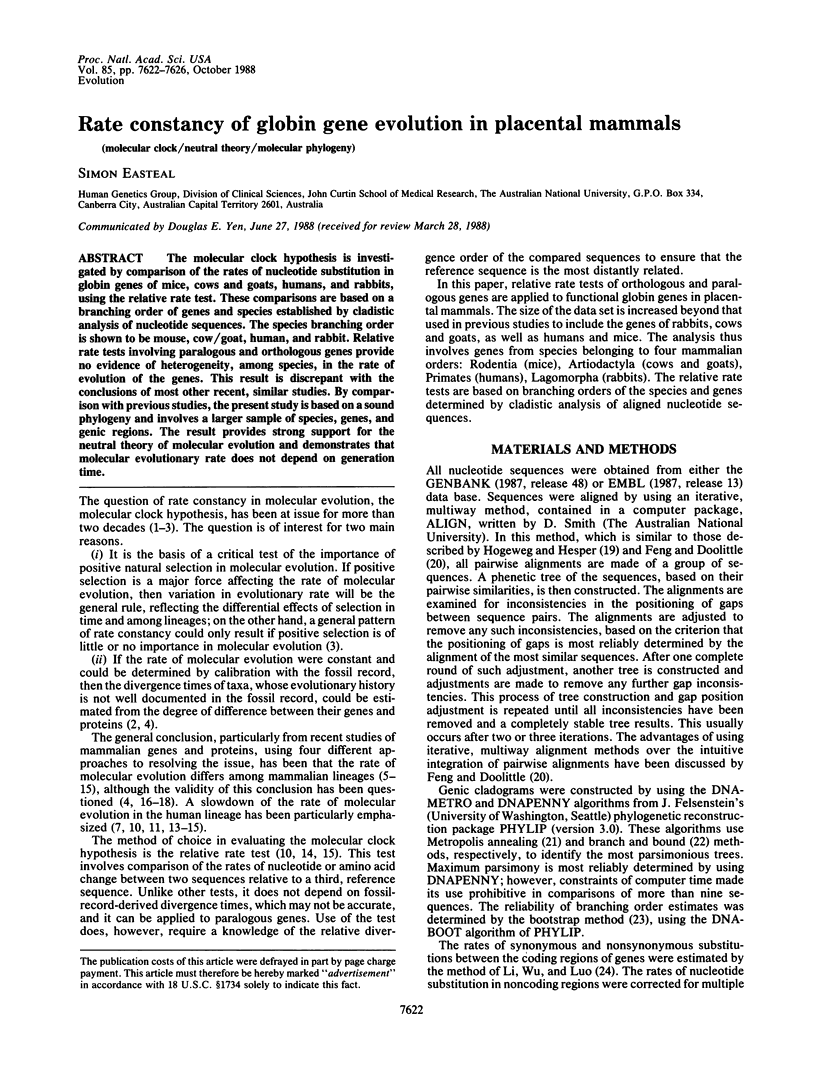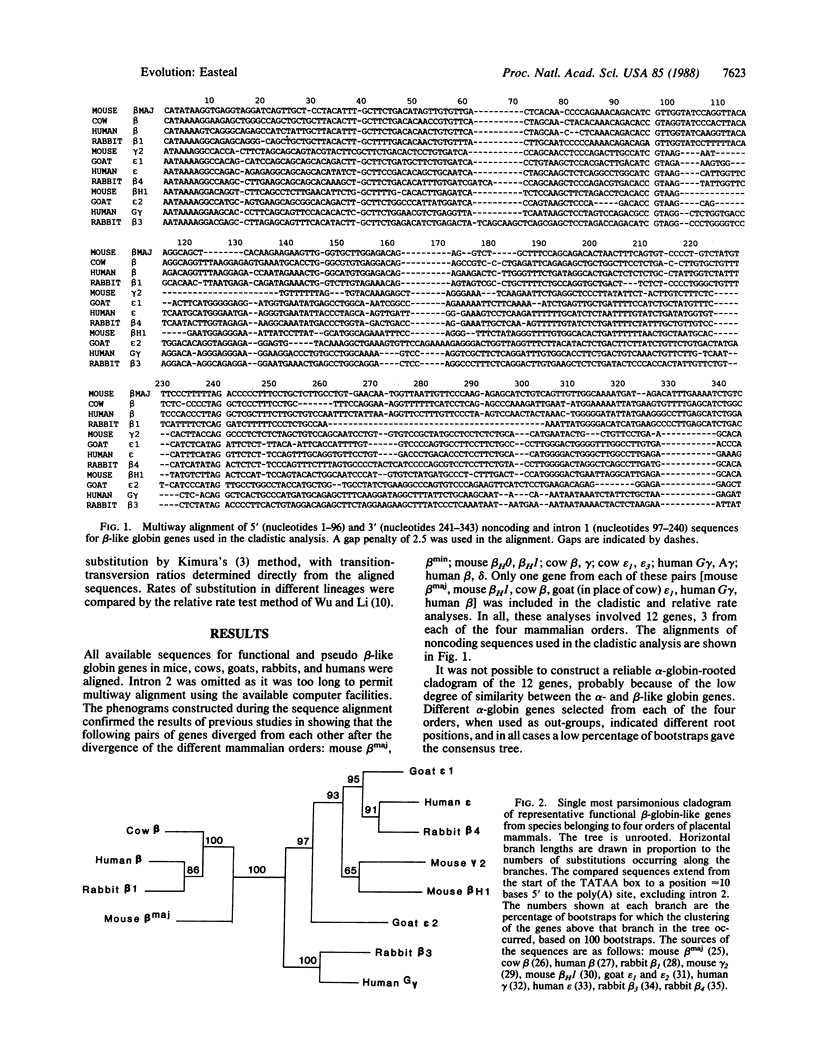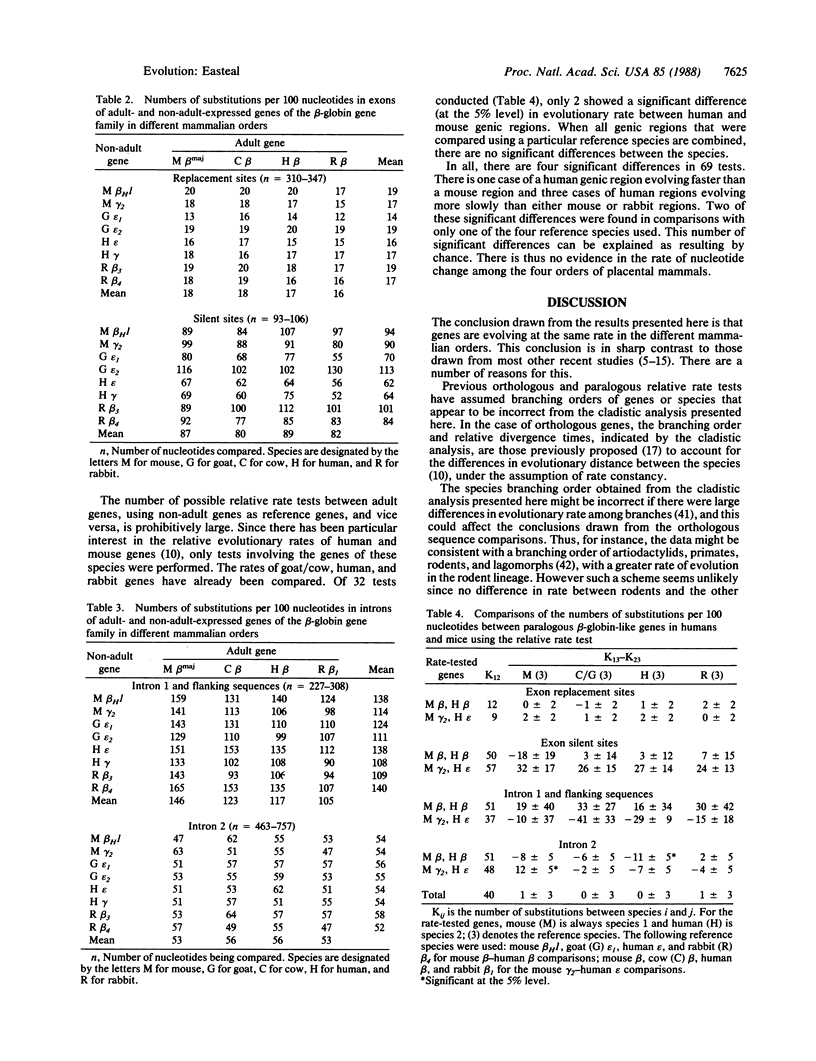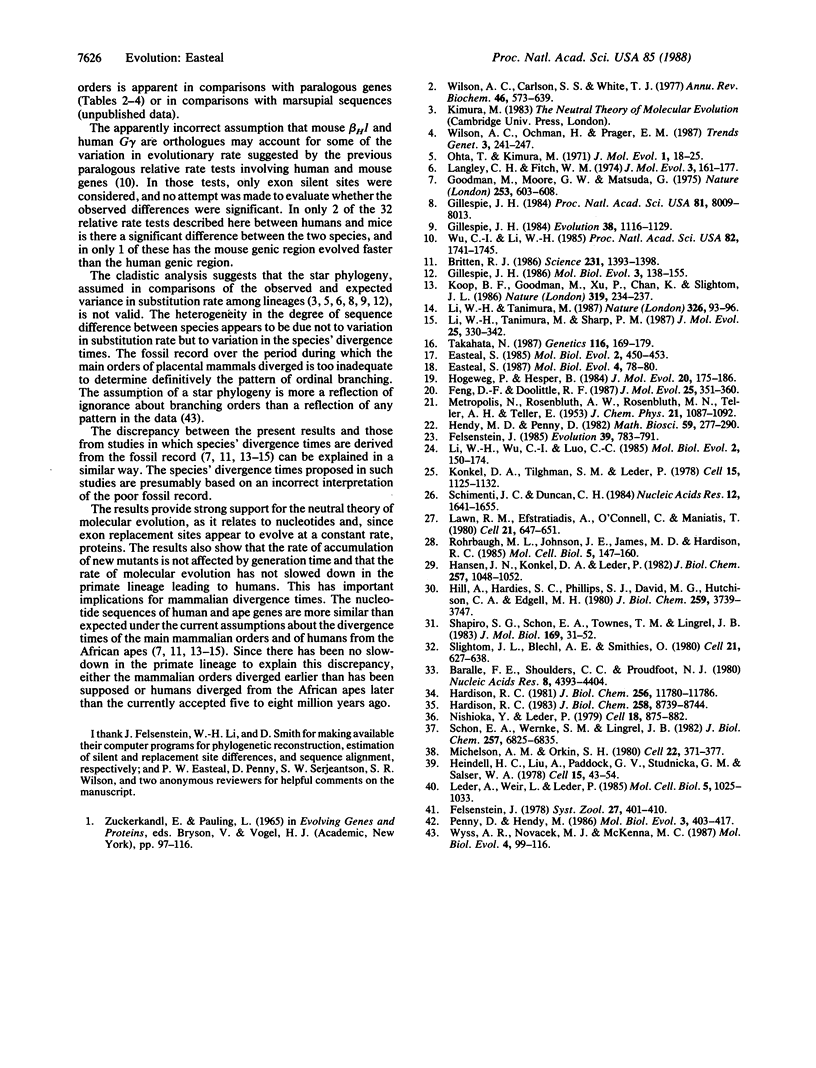Abstract
The molecular clock hypothesis is investigated by comparison of the rates of nucleotide substitution in globin genes of mice, cows and goats, humans, and rabbits, using the relative rate test. These comparisons are based on a branching order of genes and species established by cladistic analysis of nucleotide sequences. The species branching order is shown to be mouse, cow/goat, human, and rabbit. Relative rate tests involving paralogous and orthologous genes provide no evidence of heterogeneity, among species, in the rate of evolution of the genes. This result is discrepant with the conclusions of most other recent, similar studies. By comparison with previous studies, the present study is based on a sound phylogeny and involves a larger sample of species, genes, and genic regions. The result provides strong support for the neutral theory of molecular evolution and demonstrates that molecular evolutionary rate does not depend on generation time.
Full text
PDF




Selected References
These references are in PubMed. This may not be the complete list of references from this article.
- Baralle F. E., Shoulders C. C., Goodbourn S., Jeffreys A., Proudfoot N. J. The 5' flanking region of human epsilon-globin gene. Nucleic Acids Res. 1980 Oct 10;8(19):4393–4404. doi: 10.1093/nar/8.19.4393. [DOI] [PMC free article] [PubMed] [Google Scholar]
- Britten R. J. Rates of DNA sequence evolution differ between taxonomic groups. Science. 1986 Mar 21;231(4744):1393–1398. doi: 10.1126/science.3082006. [DOI] [PubMed] [Google Scholar]
- Easteal S. Generation time and the rate of molecular evolution. Mol Biol Evol. 1985 Sep;2(5):450–453. doi: 10.1093/oxfordjournals.molbev.a040361. [DOI] [PubMed] [Google Scholar]
- Feng D. F., Doolittle R. F. Progressive sequence alignment as a prerequisite to correct phylogenetic trees. J Mol Evol. 1987;25(4):351–360. doi: 10.1007/BF02603120. [DOI] [PubMed] [Google Scholar]
- Gillespie J. H. Natural selection and the molecular clock. Mol Biol Evol. 1986 Mar;3(2):138–155. doi: 10.1093/oxfordjournals.molbev.a040382. [DOI] [PubMed] [Google Scholar]
- Gillespie J. H. The molecular clock may be an episodic clock. Proc Natl Acad Sci U S A. 1984 Dec;81(24):8009–8013. doi: 10.1073/pnas.81.24.8009. [DOI] [PMC free article] [PubMed] [Google Scholar]
- Goodman M., Moore G. W., Matsuda G. Darwinian evolution in the genealogy of haemoglobin. Nature. 1975 Feb 20;253(5493):603–608. doi: 10.1038/253603a0. [DOI] [PubMed] [Google Scholar]
- Hansen J. N., Konkel D. A., Leder P. The sequence of a mouse embryonic beta-globin gene. Evolution of the gene and its signal region. J Biol Chem. 1982 Jan 25;257(2):1048–1052. [PubMed] [Google Scholar]
- Hardison R. C. The nucleotide sequence of rabbit embryonic globin gene beta 3. J Biol Chem. 1981 Nov 25;256(22):11780–11786. [PubMed] [Google Scholar]
- Hardison R. C. The nucleotide sequence of the rabbit embryonic globin gene beta 4. J Biol Chem. 1983 Jul 25;258(14):8739–8744. [PubMed] [Google Scholar]
- Heindell H. C., Liu A., Paddock G. V., Studnicka G. M., Salser W. A. The primary sequence of rabbit alpha-globin mRNA. Cell. 1978 Sep;15(1):43–54. doi: 10.1016/0092-8674(78)90081-8. [DOI] [PubMed] [Google Scholar]
- Hill A., Hardies S. C., Phillips S. J., Davis M. G., Hutchison C. A., 3rd, Edgell M. H. Two mouse early embryonic beta-globin gene sequences. Evolution of the nonadult beta-globins. J Biol Chem. 1984 Mar 25;259(6):3739–3747. [PubMed] [Google Scholar]
- Hogeweg P., Hesper B. The alignment of sets of sequences and the construction of phyletic trees: an integrated method. J Mol Evol. 1984;20(2):175–186. doi: 10.1007/BF02257378. [DOI] [PubMed] [Google Scholar]
- Konkel D. A., Tilghman S. M., Leder P. The sequence of the chromosomal mouse beta-globin major gene: homologies in capping, splicing and poly(A) sites. Cell. 1978 Dec;15(4):1125–1132. doi: 10.1016/0092-8674(78)90040-5. [DOI] [PubMed] [Google Scholar]
- Koop B. F., Goodman M., Xu P., Chan K., Slightom J. L. Primate eta-globin DNA sequences and man's place among the great apes. Nature. 1986 Jan 16;319(6050):234–238. doi: 10.1038/319234a0. [DOI] [PubMed] [Google Scholar]
- Langley C. H., Fitch W. M. An examination of the constancy of the rate of molecular evolution. J Mol Evol. 1974;3(3):161–177. doi: 10.1007/BF01797451. [DOI] [PubMed] [Google Scholar]
- Lawn R. M., Efstratiadis A., O'Connell C., Maniatis T. The nucleotide sequence of the human beta-globin gene. Cell. 1980 Oct;21(3):647–651. doi: 10.1016/0092-8674(80)90428-6. [DOI] [PubMed] [Google Scholar]
- Leder A., Weir L., Leder P. Characterization, expression, and evolution of the mouse embryonic zeta-globin gene. Mol Cell Biol. 1985 May;5(5):1025–1033. doi: 10.1128/mcb.5.5.1025. [DOI] [PMC free article] [PubMed] [Google Scholar]
- Li W. H., Tanimura M., Sharp P. M. An evaluation of the molecular clock hypothesis using mammalian DNA sequences. J Mol Evol. 1987;25(4):330–342. doi: 10.1007/BF02603118. [DOI] [PubMed] [Google Scholar]
- Li W. H., Tanimura M. The molecular clock runs more slowly in man than in apes and monkeys. Nature. 1987 Mar 5;326(6108):93–96. doi: 10.1038/326093a0. [DOI] [PubMed] [Google Scholar]
- Li W. H., Wu C. I., Luo C. C. A new method for estimating synonymous and nonsynonymous rates of nucleotide substitution considering the relative likelihood of nucleotide and codon changes. Mol Biol Evol. 1985 Mar;2(2):150–174. doi: 10.1093/oxfordjournals.molbev.a040343. [DOI] [PubMed] [Google Scholar]
- Michelson A. M., Orkin S. H. The 3' untranslated regions of the duplicated human alpha-globin genes are unexpectedly divergent. Cell. 1980 Nov;22(2 Pt 2):371–377. doi: 10.1016/0092-8674(80)90347-5. [DOI] [PubMed] [Google Scholar]
- Nishioka Y., Leder P. The complete sequence of a chromosomal mouse alpha--globin gene reveals elements conserved throughout vertebrate evolution. Cell. 1979 Nov;18(3):875–882. doi: 10.1016/0092-8674(79)90139-9. [DOI] [PubMed] [Google Scholar]
- Ota T., Kimura M. On the constancy of the evolutionary rate of cistrons. J Mol Evol. 1971;1(1):18–25. doi: 10.1007/BF01659391. [DOI] [PubMed] [Google Scholar]
- Penny D., Hendy M. Estimating the reliability of evolutionary trees. Mol Biol Evol. 1986 Sep;3(5):403–417. doi: 10.1093/oxfordjournals.molbev.a040407. [DOI] [PubMed] [Google Scholar]
- Rohrbaugh M. L., Johnson J. E., 3rd, James M. D., Hardison R. C. Transcription unit of the rabbit beta 1 globin gene. Mol Cell Biol. 1985 Jan;5(1):147–160. doi: 10.1128/mcb.5.1.147. [DOI] [PMC free article] [PubMed] [Google Scholar]
- Schimenti J. C., Duncan C. H. Ruminant globin gene structures suggest an evolutionary role for Alu-type repeats. Nucleic Acids Res. 1984 Feb 10;12(3):1641–1655. doi: 10.1093/nar/12.3.1641. [DOI] [PMC free article] [PubMed] [Google Scholar]
- Schon E. A., Wernke S. M., Lingrel J. B. Gene conversion of two functional goat alpha-globin genes preserves only minimal flanking sequences. J Biol Chem. 1982 Jun 25;257(12):6825–6835. [PubMed] [Google Scholar]
- Shapiro S. G., Schon E. A., Townes T. M., Lingrel J. B. Sequence and linkage of the goat epsilon I and epsilon II beta-globin genes. J Mol Biol. 1983 Sep 5;169(1):31–52. doi: 10.1016/s0022-2836(83)80174-0. [DOI] [PubMed] [Google Scholar]
- Slightom J. L., Blechl A. E., Smithies O. Human fetal G gamma- and A gamma-globin genes: complete nucleotide sequences suggest that DNA can be exchanged between these duplicated genes. Cell. 1980 Oct;21(3):627–638. doi: 10.1016/0092-8674(80)90426-2. [DOI] [PubMed] [Google Scholar]
- Takahata N. On the overdispersed molecular clock. Genetics. 1987 May;116(1):169–179. doi: 10.1093/genetics/116.1.169. [DOI] [PMC free article] [PubMed] [Google Scholar]
- Wilson A. C., Carlson S. S., White T. J. Biochemical evolution. Annu Rev Biochem. 1977;46:573–639. doi: 10.1146/annurev.bi.46.070177.003041. [DOI] [PubMed] [Google Scholar]
- Wu C. I., Li W. H. Evidence for higher rates of nucleotide substitution in rodents than in man. Proc Natl Acad Sci U S A. 1985 Mar;82(6):1741–1745. doi: 10.1073/pnas.82.6.1741. [DOI] [PMC free article] [PubMed] [Google Scholar]
- Wyss A. R., Novacek M. J., McKenna M. C. Amino acid sequence versus morphological data and the interordinal relationships of mammals. Mol Biol Evol. 1987 Mar;4(2):99–116. doi: 10.1093/oxfordjournals.molbev.a040435. [DOI] [PubMed] [Google Scholar]


